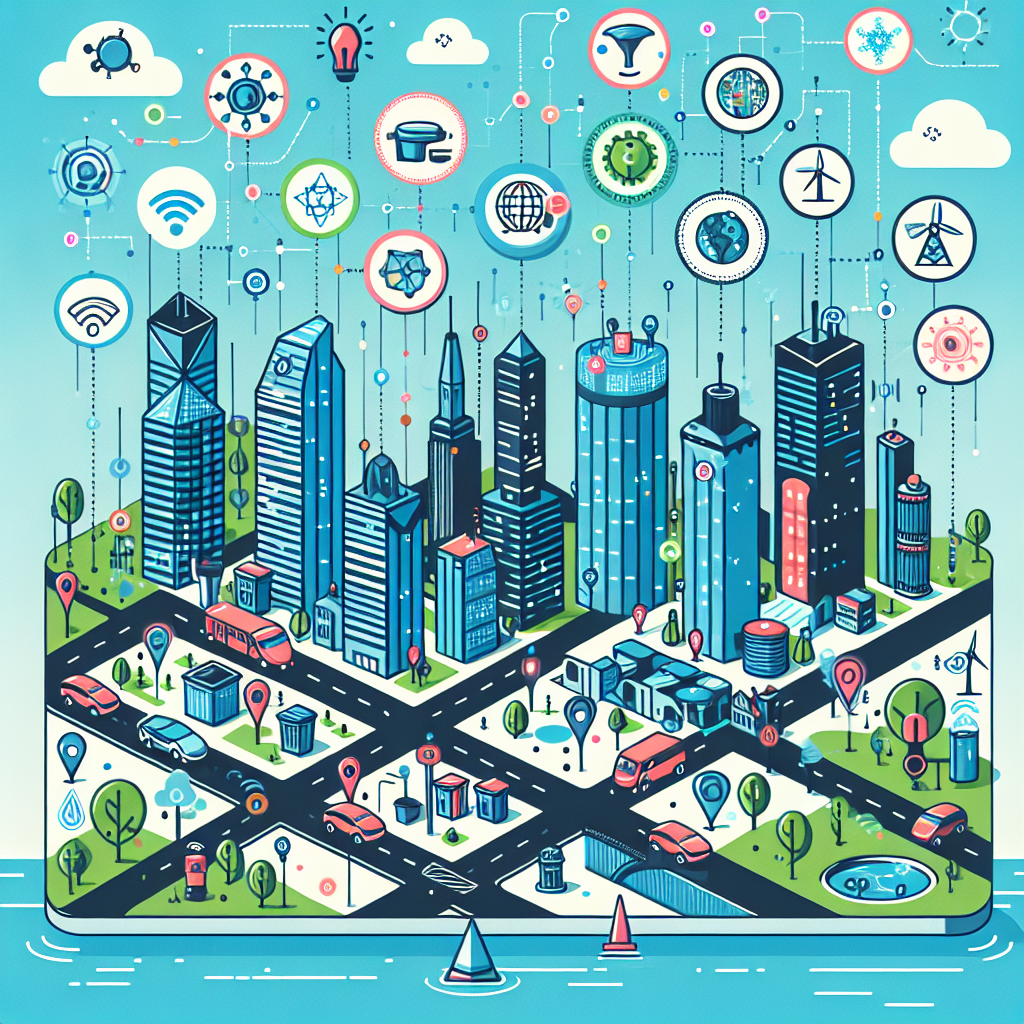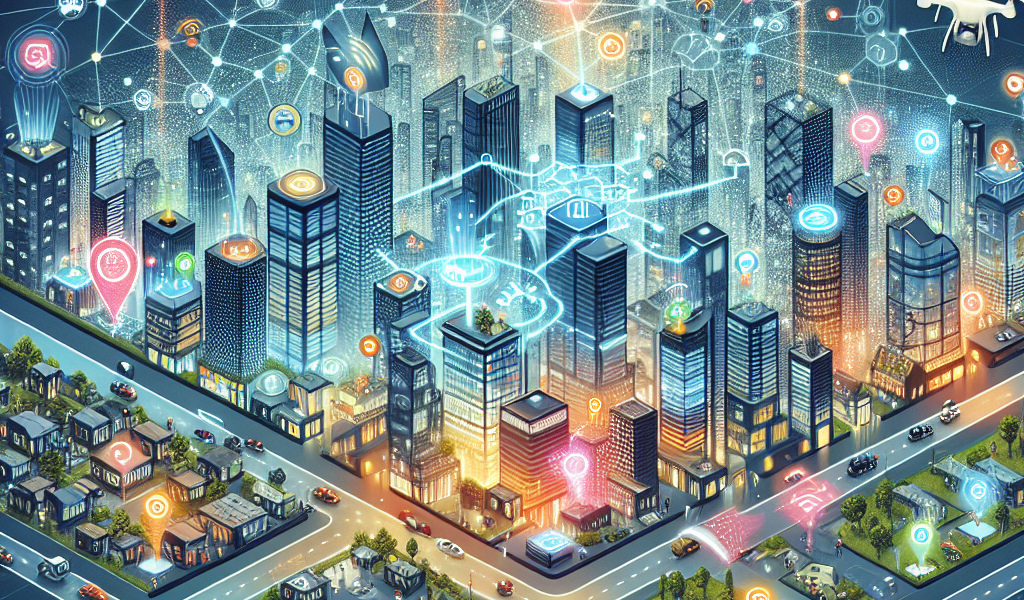-
Table of Contents
“Connecting Urban Life: The Role of IoT in Building Smarter Cities”
Introduction

The Role of IoT in Creating Smart Cities
The Internet of Things (IoT) is revolutionizing urban landscapes by enabling the development of smart cities, where interconnected devices and systems enhance the quality of life for residents. IoT technology integrates various city functions, from transportation and energy management to public safety and healthcare, through a network of sensors, data analytics, and real-time communication. This interconnected infrastructure allows for efficient resource management, reduced environmental impact, and improved public services. By leveraging IoT, cities can become more responsive, sustainable, and livable, addressing the challenges of urbanization and fostering economic growth.
Enhancing Urban Mobility Through IoT
The rapid urbanization of the 21st century has brought with it a host of challenges, particularly in the realm of urban mobility. As cities expand and populations grow, the need for efficient, sustainable, and intelligent transportation systems becomes increasingly critical. The Internet of Things (IoT) has emerged as a pivotal technology in addressing these challenges, offering innovative solutions that enhance urban mobility and contribute to the development of smart cities.
One of the primary ways IoT is transforming urban mobility is through the optimization of traffic management systems. By deploying a network of interconnected sensors and devices, cities can collect real-time data on traffic flow, congestion, and road conditions. This data is then analyzed to provide actionable insights, enabling city planners and traffic management authorities to make informed decisions. For instance, adaptive traffic signal control systems can adjust the timing of traffic lights based on current traffic conditions, thereby reducing congestion and improving the overall flow of vehicles.
In addition to traffic management, IoT plays a crucial role in enhancing public transportation systems. Smart buses and trains equipped with IoT devices can communicate their location, speed, and occupancy levels to a central system. This information can be used to optimize routes, reduce wait times, and improve the reliability of public transit. Passengers, in turn, benefit from real-time updates on arrival times and seat availability, making their commuting experience more convenient and efficient.
Moreover, IoT facilitates the integration of various modes of transportation, creating a seamless and interconnected urban mobility ecosystem. For example, smart parking solutions use IoT sensors to monitor the availability of parking spaces in real-time. Drivers can access this information through mobile apps, reducing the time spent searching for parking and decreasing traffic congestion. Similarly, bike-sharing and ride-hailing services can be integrated into the city’s transportation network, providing residents with a range of options for their daily commute.
The role of IoT in urban mobility extends beyond just improving efficiency; it also contributes to sustainability efforts. By enabling more efficient traffic management and promoting the use of public transportation, IoT helps reduce greenhouse gas emissions and energy consumption. Additionally, electric vehicles (EVs) are becoming an integral part of smart cities, and IoT technology is essential for managing EV charging infrastructure. Smart charging stations can communicate with EVs to optimize charging times and reduce strain on the power grid, further supporting the city’s sustainability goals.
Furthermore, IoT enhances the safety and security of urban mobility systems. Connected vehicles equipped with IoT sensors can detect potential hazards, such as obstacles on the road or sudden changes in weather conditions, and communicate this information to other vehicles and traffic management systems. This real-time exchange of data can help prevent accidents and improve overall road safety. Additionally, IoT-enabled surveillance systems can monitor public transportation hubs and other critical infrastructure, ensuring the safety of passengers and deterring criminal activities.
In conclusion, the integration of IoT into urban mobility systems is a key driver in the development of smart cities. By leveraging real-time data and interconnected devices, cities can optimize traffic management, enhance public transportation, promote sustainability, and improve safety. As technology continues to advance, the potential for IoT to revolutionize urban mobility will only grow, paving the way for smarter, more efficient, and more livable cities.
IoT-Driven Energy Efficiency in Smart Cities
The Role of IoT in Creating Smart Cities
In the quest to develop smart cities, the Internet of Things (IoT) has emerged as a pivotal technology, particularly in the realm of energy efficiency. As urban areas continue to expand, the demand for sustainable and efficient energy solutions has never been more critical. IoT-driven energy efficiency initiatives are transforming how cities manage resources, reduce waste, and enhance the quality of life for their inhabitants.
One of the primary ways IoT contributes to energy efficiency in smart cities is through the deployment of smart grids. These advanced electrical grids utilize IoT sensors and devices to monitor and manage energy consumption in real-time. By collecting and analyzing data on energy usage patterns, smart grids can optimize the distribution of electricity, reducing energy loss and ensuring that power is delivered where it is needed most. This not only minimizes waste but also helps to prevent blackouts and other disruptions, thereby enhancing the reliability of the energy supply.
Moreover, IoT technology enables the integration of renewable energy sources into the urban energy mix. Solar panels, wind turbines, and other renewable energy installations can be equipped with IoT sensors to monitor their performance and output. This data can then be used to adjust the energy grid dynamically, ensuring that renewable energy is utilized efficiently and effectively. Consequently, cities can reduce their reliance on fossil fuels, lower their carbon footprint, and move closer to achieving their sustainability goals.
In addition to optimizing energy distribution, IoT plays a crucial role in enhancing energy efficiency within buildings. Smart buildings, equipped with IoT devices, can monitor and control various systems such as heating, ventilation, air conditioning (HVAC), lighting, and security. For instance, IoT sensors can detect occupancy levels and adjust lighting and HVAC systems accordingly, ensuring that energy is not wasted in unoccupied spaces. Furthermore, predictive maintenance enabled by IoT can identify potential issues in building systems before they become significant problems, thereby reducing energy consumption and maintenance costs.
Transportation is another sector where IoT-driven energy efficiency is making a significant impact. Smart traffic management systems, powered by IoT, can monitor traffic flow and optimize signal timings to reduce congestion and minimize fuel consumption. Additionally, IoT-enabled public transportation systems can provide real-time information to commuters, encouraging the use of energy-efficient modes of transport. Electric vehicle (EV) charging infrastructure, integrated with IoT, can also optimize charging schedules based on grid demand, further enhancing energy efficiency.
The benefits of IoT-driven energy efficiency extend beyond environmental sustainability. By reducing energy consumption and optimizing resource use, cities can achieve significant cost savings. These savings can be reinvested in other critical areas such as healthcare, education, and infrastructure development, thereby improving the overall quality of life for residents. Furthermore, the data generated by IoT devices can provide valuable insights for city planners and policymakers, enabling them to make informed decisions and develop more effective strategies for urban development.
However, the implementation of IoT-driven energy efficiency initiatives is not without challenges. Issues such as data privacy, cybersecurity, and the need for robust infrastructure must be addressed to ensure the successful deployment of IoT technologies. Collaboration between government agencies, private sector stakeholders, and the community is essential to overcome these challenges and realize the full potential of IoT in creating smart cities.
In conclusion, IoT-driven energy efficiency is a cornerstone of smart city development. By optimizing energy distribution, integrating renewable sources, enhancing building efficiency, and improving transportation systems, IoT technology is helping cities become more sustainable, resilient, and livable. As urbanization continues to accelerate, the role of IoT in creating smart cities will only become more critical, paving the way for a more sustainable future.
Improving Public Safety with IoT Technologies
The integration of Internet of Things (IoT) technologies into urban environments is revolutionizing the way cities operate, particularly in the realm of public safety. As cities grow and become more complex, the need for efficient, responsive, and proactive safety measures becomes increasingly critical. IoT technologies offer a promising solution by enabling real-time data collection, analysis, and response, thereby enhancing the ability of city authorities to maintain public safety.
One of the primary ways IoT contributes to public safety is through the deployment of smart surveillance systems. Traditional surveillance cameras, while useful, often require manual monitoring and are limited in their ability to provide real-time alerts. In contrast, IoT-enabled cameras equipped with advanced analytics and machine learning algorithms can automatically detect unusual activities, such as unattended bags or suspicious movements, and immediately notify law enforcement agencies. This not only speeds up response times but also allows for more efficient allocation of resources, as officers can be dispatched to areas where they are most needed.
Moreover, IoT technologies facilitate the creation of interconnected emergency response systems. For instance, smart sensors can be installed in public spaces to detect environmental hazards such as gas leaks, fires, or chemical spills. These sensors can instantly relay information to emergency services, enabling a swift and coordinated response. Additionally, IoT devices can be integrated with public transportation systems to monitor and manage traffic flow, ensuring that emergency vehicles can reach their destinations without unnecessary delays. This interconnectedness is crucial in minimizing the impact of emergencies and safeguarding public health and safety.
Another significant contribution of IoT to public safety is in the realm of predictive analytics. By collecting and analyzing vast amounts of data from various sources, such as social media, weather reports, and historical crime data, IoT systems can identify patterns and predict potential safety threats. For example, predictive policing models can forecast crime hotspots, allowing law enforcement agencies to deploy officers more strategically. Similarly, predictive maintenance of infrastructure, such as bridges and roads, can prevent accidents by identifying and addressing potential issues before they become critical.
Furthermore, IoT technologies enhance public safety through improved communication and information dissemination. In the event of an emergency, IoT-enabled public address systems and digital signage can provide real-time updates and instructions to citizens, helping to manage crowds and reduce panic. Mobile applications connected to IoT networks can also send alerts directly to individuals’ smartphones, ensuring that people receive timely and accurate information regardless of their location. This level of communication is vital in ensuring that the public remains informed and can take appropriate actions to protect themselves.
In addition to these direct applications, IoT technologies also support public safety by fostering greater community engagement. Smart city platforms often include features that allow residents to report issues, such as broken streetlights or hazardous conditions, directly to city authorities. This not only helps to address problems more quickly but also encourages a collaborative approach to public safety, where citizens play an active role in maintaining their own security.
In conclusion, the role of IoT in creating smart cities extends far beyond convenience and efficiency; it is a transformative force in enhancing public safety. Through smart surveillance, interconnected emergency response systems, predictive analytics, improved communication, and community engagement, IoT technologies provide city authorities with the tools they need to protect their citizens more effectively. As these technologies continue to evolve, their potential to create safer, more resilient urban environments will only grow, making IoT an indispensable component of the smart cities of the future.
Smart Waste Management Solutions Using IoT
The rapid urbanization of the 21st century has brought with it a host of challenges, particularly in the realm of waste management. As cities expand, the volume of waste generated increases exponentially, necessitating innovative solutions to manage it efficiently. Enter the Internet of Things (IoT), a technological marvel that is revolutionizing various sectors, including waste management. By leveraging IoT, cities are now able to implement smart waste management solutions that not only enhance efficiency but also promote sustainability.
One of the primary ways IoT is transforming waste management is through the use of smart bins. These bins are equipped with sensors that monitor the fill levels in real-time. When a bin reaches a certain capacity, the sensor sends a notification to the waste management authorities, prompting timely collection. This system eliminates the need for routine checks and reduces the frequency of collection trips, thereby saving time and resources. Moreover, it ensures that bins do not overflow, maintaining cleanliness and hygiene in urban areas.
In addition to smart bins, IoT-enabled waste management systems also incorporate route optimization for waste collection trucks. Traditional waste collection routes are often fixed and do not account for the varying fill levels of bins. However, with IoT, data from smart bins can be analyzed to create dynamic routes that prioritize bins that are nearing capacity. This not only reduces fuel consumption and emissions but also enhances the overall efficiency of the waste collection process.
Furthermore, IoT technology facilitates better data collection and analysis, which is crucial for effective waste management. By gathering data on waste generation patterns, authorities can identify trends and make informed decisions. For instance, they can determine which areas generate the most waste and allocate resources accordingly. This data-driven approach enables cities to optimize their waste management strategies and improve their sustainability efforts.
Another significant advantage of IoT in waste management is its potential to promote recycling. Smart bins can be designed to segregate waste at the source, making it easier to recycle materials. Sensors can detect the type of waste being disposed of and direct it to the appropriate compartment within the bin. This not only simplifies the recycling process but also encourages citizens to participate in waste segregation, fostering a culture of environmental responsibility.
Moreover, IoT can play a pivotal role in reducing illegal dumping, a persistent issue in many urban areas. By installing sensors and cameras in strategic locations, authorities can monitor and detect unauthorized waste disposal activities. Real-time alerts can be sent to enforcement agencies, enabling swift action against offenders. This not only deters illegal dumping but also helps maintain the aesthetic appeal of the city.
While the benefits of IoT in waste management are evident, it is important to acknowledge the challenges associated with its implementation. The initial cost of deploying IoT infrastructure can be high, and there may be concerns regarding data privacy and security. However, with proper planning and investment, these challenges can be mitigated, paving the way for smarter and more sustainable cities.
In conclusion, IoT is playing a crucial role in revolutionizing waste management in urban areas. Through smart bins, route optimization, data-driven decision-making, enhanced recycling, and the prevention of illegal dumping, IoT is helping cities manage waste more efficiently and sustainably. As technology continues to advance, the integration of IoT in waste management will undoubtedly become more sophisticated, further enhancing the quality of life in smart cities.
Conclusion
The role of IoT in creating smart cities is pivotal, as it enables the integration of various systems and services to enhance urban living. IoT facilitates real-time data collection and analysis, leading to improved efficiency in energy management, transportation, waste management, and public safety. By connecting devices and infrastructure, IoT helps in optimizing resource usage, reducing operational costs, and providing better services to citizens. Ultimately, IoT contributes to the development of sustainable, resilient, and more livable urban environments, addressing the challenges of rapid urbanization and resource constraints.





